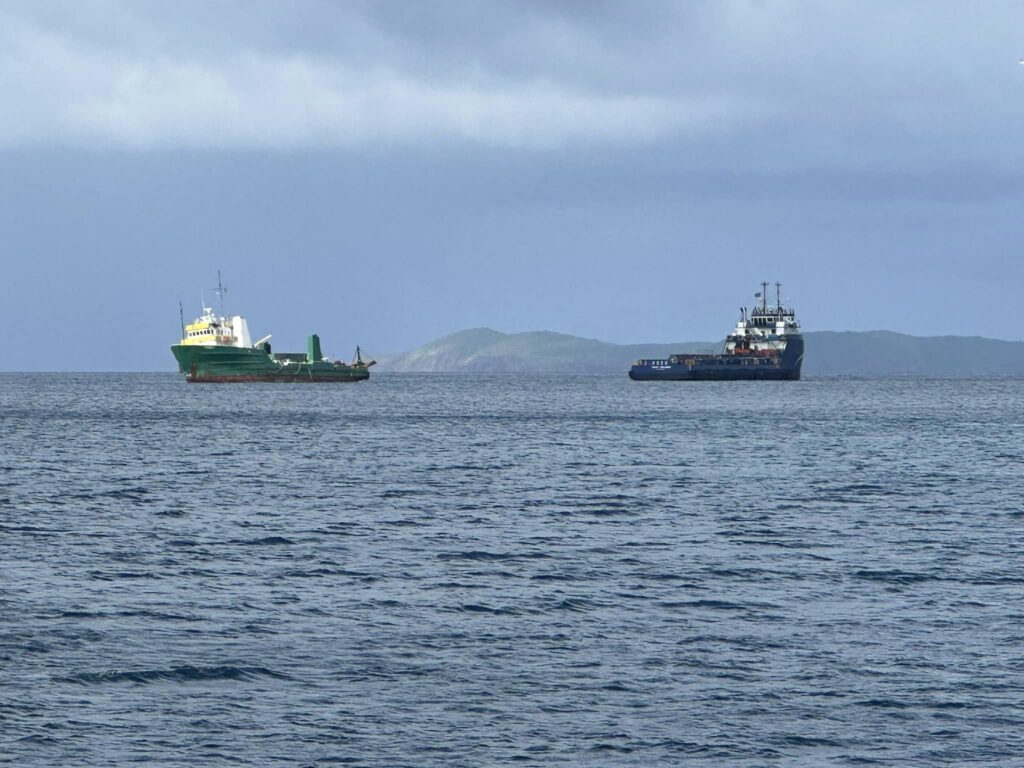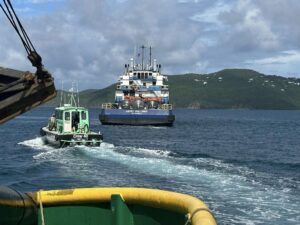CHARLOTTE AMALIE — Did you wake up this morning in St. Thomas and see an extra boat off the Cyril E. King Airport?
This is good news!
The Harvey Challenger, an offshore supply vessel from Louisiana, is here to remove all the fuel from the stranded Bonnie G cargo vessel.
“Safety zone is in affect, please respect it and give responders a safe area to work,” the Coast Guard said.

The Coast Guard established the safety zone around the cargo vessel Bonnie G grounding site, Friday, as the Incident Command continues coordinated efforts with partner agencies in support of the ongoing response.
The safety zone extends one quarter mile around the Bonnie G for the duration of the response. Commercial and recreational vessel traffic should remain clear of this area for their safety and the safety of response crews working the site.
The Bonnie G continues to remain stable and there are no reports of oil discharge or visible oil sheen observed in the water.
During Friday’s response efforts, National Response Corporation and Playland Marine LLC oil spill removal organization (OSRO) crews are on scene with Coast Guard personnel conducting assessments, draft readings and soundings to develop a safety and salvage plan. Donjon Marine Co. divers are simultaneously conducting an underwater assessment of the vessel’s hull and the subsurface marine environment.
OSRO crew has removed batteries from the vehicles and the vessel crew are installing a solar panel to supply lighting and Automatic Identification System transmission on the Bonnie G, so the vessel will be visible to other maritime traffic to reduce the potential of further incidents.
During Thursday’s activities, OSRO crews reported that they embarked the Bonnie G and closed all watertight hatches to prevent progressive flooding and placed 100-feet of containment boom around the stern of the Bonnie G to contain any potential oil pollutants from discharging.
Coast Guard crews continue to work closely with the responsible party and the OSRO, as well as the Virgin Islands Territorial Emergency Management Agency, the National Oceanic and Atmospheric Administration, the U.S. Fish and Wildlife Service, the Coral Center, local government officials and other stakeholders supporting the response.
“Our main priorities in the Bonnie G response are the safety of responders, mariners and the U.S. Virgin Islands boating community, the protection of the marine environment and the protection of the Charlotte Amalie port area,” said Capt. José E. Díaz, Incident Commander for the Bonnie G response. “We appreciate all of the collaborative support in this response effort from the federal and local government entities as well as valuable partners and stakeholders who are committed to protecting the pristine waters and marine environment in the U.S. Virgin Islands.”
The Bonnie G is reported to have approximately 13,000 gallons of fuel and approximately 700 gallons of lube oil onboard. Additionally, the vessel was carrying six cars, a bucket truck, a semi-truck rig, a trailer and container, two forklifts, a general-purpose lift as well as two pallets of cargo.
The Bonnie G, a 195-foot Vanuatu-flagged “ro-ro” cargo vessel, ran aground Wednesday morning, approximately half a mile south of the Cyril E. King airport in St. Thomas. All 12 persons aboard the vessel were rescued, and no injuries were reported to the Coast Guard.
Reporting a hazardous substance release or oil spill takes only a few minutes. Contact the federal government’s centralized reporting center, the National Response Center (NRC), at 1-800-424-8802. The NRC is staffed 24 hours a day by personnel who will ask you to provide as much information about the incident as possible. If reporting directly to the NRC is not possible, reports also can be made to the EPA Regional office or the nearest U.S. Coast Guard unit in the area where the incident occurred. In general, the EPA should be contacted if the incident involves a release to inland areas or inland waters. The Coast Guard should be contacted for releases to coastal waters, ports and harbors. The EPA or the Coast Guard will relay release and spill reports to the NRC promptly.

